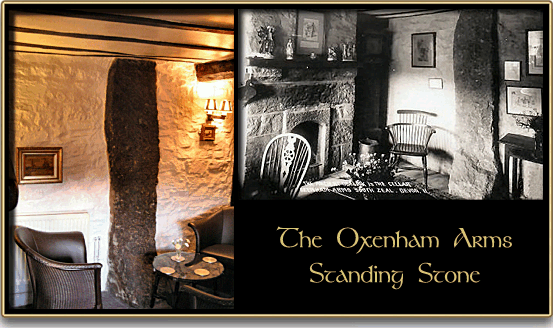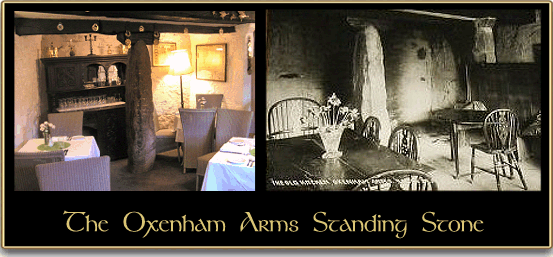
Anybody who has visited the various prehistoric ritual monuments will know that there is nothing more annoying than trekking across the moor in driving rain or mist to find them and then being unable to get a decent photograph. Well, there is one such monument you can visit that is never subject to the vagaries of the Dartmoor weather and has the added bonus of having excellent food and drink on-hand. I would suggest that the setting of this prehistoric monument has to be unique on Dartmoor if not the whole country. So, where and what?
On the northern edge of Dartmoor lies South Zeal, this is a small moorland village that nestles securely below the huge dome of Cosdon which looms high above its south western limits. This ancient settlement hides many gems, one of which is The Oxenham Arms which in turn is home to some surprising secrets. The English Heritage Pastscape Record (see link opposite) suggests that the building contains features of a post medieval inn/manor house, a medieval manor house and what this page is concerned with, a prehistoric menhir. There is very little mention of this standing stone by any of the noted Dartmoor writers such as Crossing, Hemery, Rowe or Worth but St. Ledger Gordon does note the following, (1954, p. 18):
‘There, forming part of an inner wall, is an unquestionable monolith. It rises from the floor beneath which its base is lost like that of an iceberg, then mounts to the full height of the room, as though supporting the ceiling through which it disappears. Now scheduled as an ‘Ancient Monument’, its rough granite surface may not be touched – washed, cleaned, polished, painted, draped, concealed or interfered with in any way, and probably this monument only differs from many others in that it has been discovered.’
Below is a photograph taken in the September of 2008 and an early postcard both of which clearly show the menhir firmly embedded in what is now the back bar of the inn.

But the burning question is why should a prehistoric stone that probably dates back 4,500 years be firmly encased in the wall of a later structure? One suggested theory is that the original building was of monastic origin and because the monolith was so deeply embedded in the ground it was decided that the easiest solution would be to build the wall around the stone. Apparently in the 1970s an attempt was made to find exactly how far the menhir went into the ground and according to Quick, p.73 the excavators went down to twenty six feet which seems highly unlikely. Taking this line of thought it has also been muted that perhaps this was some kind of deliberate way of ‘Christianising’ an ancient pagan symbol and converting the site into a place of holy worship? This theory could be plausible if there was any certain proof that the building was of a monastic origin which sadly there isn’t. The other question that comes to mind is why would a menhir be sited here? If you look at all the known surviving examples of Dartmoor standing stones they are all located on the open moor at altitudes of between 532 and 317 metres. This one sits at around 190 metres and certainly would not have displayed the high visibility in the landscape as the others did.
On a positive note, the monument has been scheduled and recorded as a standing stone dating from between the prehistoric and Roman eras.
But, at first sight the Oxenham Arms has another bonus which stands in what is now the restaurant in the form of another menhir. This time warn granite pillar has for many years supported a heavy wooden cross beam as can be seen from the pictures below. Again, the colour photograph was taken in September 2008 and the black and white image is an early postcard.

Very little is known about this granite pillar and it’s interesting that English Heritage do no list it on their Pastscape record. This could well be because there is a local tradition that during the 1800s the then owner added it as an embellishment to the room. It is not known whether this was an attempt at ‘forging’ another prehistoric monument or just a way of supporting a sagging beam. Once again there is no known example of two menhirs being sited so close together amongst the Dartmoor examples. Either way the granite pillar adds something to the excellent dining experience to be had at the Oxenham Arms.
On a final note, having recently stayed at The Oxenham Arms I can thoroughly recommend it to anyone who is looking for a traditional Dartmoor Hotel with comfortable rooms, excellent food, fine wines and ales all of which are at reasonable prices. Oh and as this is a legendary site there is a resident ghost who comes at no extra cost.

Quick, T. 1992. Dartmoor Inns. Tiverton: Devon Books.
St. Ledger-Gordon, G. 1954. Under Dartmoor Hills. London: Robert Hale Ltd.
 Legendary Dartmoor The many aspects past and present of Dartmoor
Legendary Dartmoor The many aspects past and present of Dartmoor
